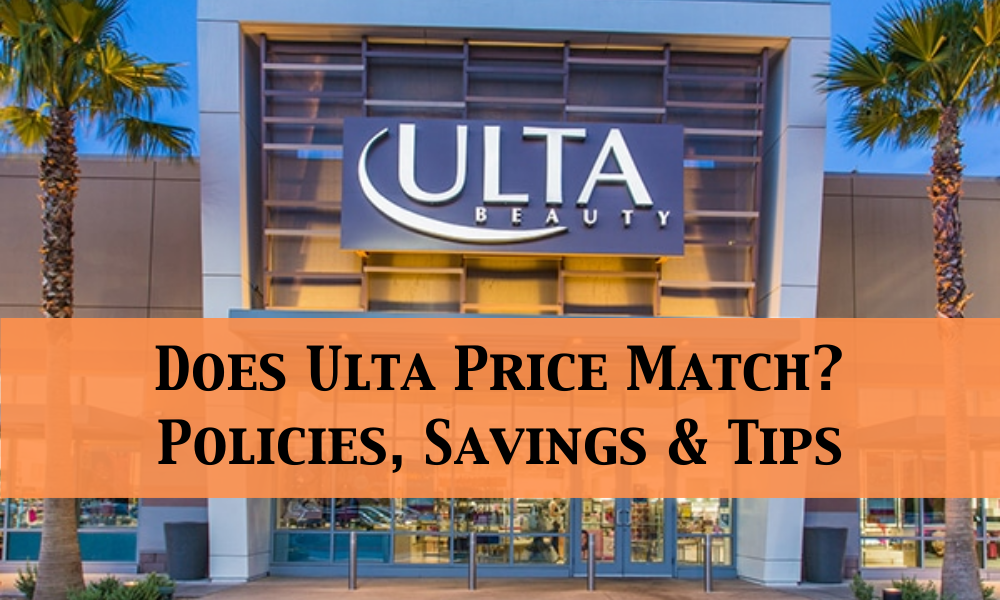
When beauty retailers like Ulta, Sephora, Amazon, Target, and Walmart dominate the market, shoppers often find overlap in their inventory of makeup, skincare, and haircare products. Whether you’re eyeing Dyson’s coveted Airwrap or simple Cetaphil cleansers, these items appear across multiple platforms.
As a loyal Ulta shopper or Ulta Beauty Rewards member, you naturally gravitate toward Ulta first when stocking up on beauty essentials. However, the burning question remains: will you get the best price? This comprehensive guide explores Ulta’s price matching and price adjustment policies to help you navigate your shopping decisions.
Does Ulta Price Match?
Unfortunately, Ulta does not price-match other retailers’ prices. This means if you spot an item for less at Sephora, Macy’s, or even Target. Where some Ulta products are sold, you cannot request Ulta to match that price, whether online or in-store.
Their price-matching policy remains firm across all channels. Ulta doesn’t price-match competitors at all. They’ll only match their own online pricing if it differs from in-store prices within 14 days. Sephora offers limited price matching with select luxury retailers like Nordstrom and Saks, but only on regular prices (non-sale prices) within 7 days. In practice, this policy provides minimal savings since most price differences occur during sales, which neither store will match.
Many savvy shoppers rely on popular deal sites to compare prices and snag the best discounts before heading to checkout.
Does Ulta match its online prices in stores?
Requesting Ulta to match prices they’re advertising online or in their app while shopping in an Ulta store presents a different story. As of 2021, Ulta employees shared on Reddit that they would, on occasion, match a price a shopper saw online or in the Ulta app at their physical Ulta store location. However, this policy doesn’t apply to all products; there are always exclusions.
While it doesn’t hurt to ask, you might not receive the adjusted price. If you cannot secure the online price while shopping in-store, consider placing an order through the app and selecting in-store pickup. Orders placed before 6 p.m. local time are typically ready within two hours. As a bonus, when you order online and opt for in-store pickup, you’ll receive 10% off your order.
Does Ulta offer price adjustments?
Purchased from Ulta last week, and now it’s available for a deeper discount? Unfortunately, you won’t secure a price adjustment. What you can do, however, if you haven’t opened the product, is return it and purchase it again on sale.
Exercise caution with this tactic, as Ulta reserves the right to limit a single customer’s returns. Still, it could prove beneficial if you haven’t used a product or tool you paid full price for, and it’s now significantly discounted. When items you just bought go on sale, both stores handle post-purchase price drops differently. Ulta’s workaround approach involves no formal price adjustment policy, but its 60-day return window creates an opportunity to return and repurchase items that go on sale within this timeframe.
This effectively allows you to get sale pricing on recent purchases, though it requires monitoring prices and making a trip to the store. Sephora handles this on a case-by-case basis without a clearly advertised price adjustment policy, though customer service may issue credits for price drops within weeks of purchase – though it’s not guaranteed and depends on timing, product, and the customer service representative.
From seasonal sales to exclusive promos, department store coupons give customers an easy way to stretch their budget further.
Does Ulta accept manufacturer’s coupons?
As a workaround to Ulta’s price-matching policy, their coupon acceptance policy offers some relief. Ulta states on its website that it accepts manufacturer’s coupons. This means if you have a coupon from a brand like Dyson, it will likely be accepted for use on your Dyson purchase at Ulta. While you cannot ask Ulta to match the price offered on Dyson, you can apply Dyson’s coupon to your purchase. Ulta.com’s team recommends showing your coupon to an Ulta employee when you shop in-store so they can apply the discount to your purchase.
Are Ulta’s prices better than Sephora’s?
When a product from a specific brand is available at both Sephora and Ulta, it’s typically sold for the same price. However, when these beauty retailers are hosting a sale or promotion, you might notice price differences. I recommend staying somewhat loyal to one retailer to accumulate as many rewards points as possible! However, for pricier purchases, it’s always wise to browse multiple stores and find the best price.
How To Save Money When Shopping at Ulta Beauty
The lack of a price-matching policy doesn’t mean you cannot save money when shopping at Ulta. There are several ways to save money, including joining Ulta’s Buy More Save More program. They offer a variety of ways for customers, especially loyal ones, to save money on a wide variety of products.
This proves particularly beneficial if you’re flexible about the precise brand you buy, enjoy browsing for interesting finds, tend to purchase many beauty products, or can work with a friend to split a bundle. There’s always a chance you’ll discover something appealing on their sales pages – though this makes them dangerous for your budget!
Price Range And Product Selection
The fundamental difference between Ulta and Sephora lies in their product mix and pricing philosophy. This distinction alone can determine which store fits your budget better. Ulta’s budget-friendly advantage positions them as a true beauty superstore, stocking everything from $3 lip balms to $80 foundation bottles under one roof. Their dual approach genius places coveted high-end brands like Urban Decay and Tarte alongside affordable drugstore favorites like e.l.f. and CeraVe.
This mix creates real money-saving opportunities: product variety at every price point lets you choose between a $7 e.l.f. concealer or splurge on $31 Tarte Shape Tape during the same shopping trip. Complete routines under $50 become achievable as shoppers build full makeup collections by strategically mixing drugstore and mid-range products. Instant budget flexibility allows you to swap expensive items for budget alternatives without leaving the store, making it easier to stick to spending limits. Access to drugstore exclusives means finding cult-favorite budget brands like The Ordinary, CeraVe, and Neutrogena alongside luxury options.
Sephora’s premium positioning takes a different approach, focusing almost exclusively on prestige and luxury brands. Walk into any Sephora location and you’ll notice the absence of true drugstore products. While Sephora Collection (their house brand) offers some mid-range options – like a $15 concealer compared to higher-end $30+ alternatives – the overall selection skews expensive. This curated approach means your typical Sephora shopping trip feels pricier because you won’t find those $5-10 budget alternatives that could round out your routine. Every product category starts at a higher price point, making it challenging to build an affordable makeup collection.
With the right clothing coupon codes, updating your wardrobe becomes stylish and budget-friendly.
Coupons and sale discounts
Beyond product pricing, the real money-saving magic happens through coupons, sales, and promotional strategies. Here’s where the two retailers take dramatically different approaches to helping customers save. Ulta’s coupon-friendly culture has built its reputation on making coupons and discounts easily accessible to shoppers. The store consistently offers multiple ways to slash your total at checkout.
Regular coupon offerings include $3.50 off $15 purchase available weekly through their app, website, and store flyers, usable multiple times by splitting larger purchases. 20% off entire purchase, periodic coupons work on prestige brands during special promotional periods. BOGO deals run year-round as buy-one-get-one promotions across various product categories, while buy more save more sales offer tiered discounts that increase with your spending amount.
The stacking advantage represents Ulta’s biggest money-saving secret: coupon stacking. You can combine manufacturer coupons (like those newspaper clippings for L’Oréal or CoverGirl) with Ulta store coupons on the same purchase. This means you could potentially use a BOGO sale price, apply a manufacturer’s coupon, then add Ulta’s $3.50 store coupon in one transaction, creating massive savings that can cut your bill in half. Sephora takes a much more restrictive approach to coupons and everyday discounts. The luxury retailer rarely offers traditional money-off coupons, instead focusing on sample promotions and limited-time offers.
Their limited promotional options include a 10% welcome discount as a one-time offer for new customers who sign up for marketing texts, credit card bonus of 15% off first purchase for new Sephora credit cardholders, sample promotions featuring free products with minimum purchase thresholds rather than money off, and no manufacturer coupons – Sephora doesn’t accept outside coupons, limiting your stacking opportunities.
Who saves you more – Ulta or Sephora?
After comparing every aspect of these beauty retail giants from a pure money-saving perspective, the winner is clear: Ulta Beauty consistently offers more opportunities to save money than Sephora. The savings scorecard shows how each store performed across key money-saving categories.
Ulta dominates in product pricing: its mix of drugstore and prestige brands allows complete routines under $50. Coupon availability features regular $3.50 off $15 coupons, 20% off promotions, and BOGO sales. Discount stacking lets you combine manufacturer coupons, store coupons, sales, and rewards in one transaction. Rewards value enables you to earn up to 6.25% back in usable cash with points that never expire at higher tiers. Sale frequency provides multiple major sales per year with discounts of up to 50% off.
Sephora falls short with restrictive stacking (one promo code maximum), limited combining of offers, lower rewards value (only 2% cash back through Beauty Insider Cash option), and higher price floors where minimal drugstore alternatives mean higher spending minimums. Consider a typical beauty shopper spending $500 annually: at Ulta, you’d earn 500-625 points (depending on tier status), redeem for $17.50-$19 in cash back, plus regular coupon savings of $50-100+ per year for total potential savings of $70-120+ annually.
At Sephora, you’d earn 500 points, redeem for $10 in cash back, with limited coupon opportunities for total potential savings of $15-25 annually. Sephora might be worth it for certain shoppers who prioritize product discovery through their extensive sampling program that helps avoid costly mistakes, prefer luxury experiences with a premium store environment and exclusive brand access, have brand loyalty that drives purchases of exclusive products and early access to new releases, or value convenience over savings and would rather pay more for a curated, hassle-free experience.
Shoppers use a wellness discount code to grab deals on supplements, gym gear, and wellness products at lower prices.
Conclusion
Ulta may not offer price matching or formal price adjustments, but that doesn’t mean you can’t save. Their mix of high-end and drugstore products, frequent coupons, and stacking opportunities make them one of the best places to shop for beauty on a budget.
Compared to Sephora, Ulta consistently gives shoppers more flexibility and value, especially when combining rewards with discounts. If saving money is a priority, Ulta is the stronger choice. With a little planning, you can enjoy quality products without overspending.

Leave a Reply